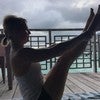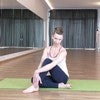Description
About This Video
Transcript
Read Full Transcript
Good afternoon, I'd like to share a wonderful body of movement, that I have found very inspirational for me, and I actually tried to touch into every day, which is based on just our natural genetic potential and our natural ability to move, just the way babies learn how to move naturally, they just organically go through different movements that set up their nervous system and develop their bodies to be vertical. Animals have a genetic natural ability to move. This is in all of us, but to a certain extent, we disconnect from this, and then, we get more rigidified and limited in our range, and our nervous system atrophies a little bit. So, this is addressing these core motions that, probably, Joseph Pilates was inspired with when he first created the methodology and started developing mat work, 'cause he used animals very extensively as his inspiration. So, just like an eagle, we're stretching out and reaching and expanding.
My cats, when they're happy, they're kneading their hands, or their paws, I should say, and when a bird is going to land, they're extending their legs. These are natural movements that we have in us, as well. And all of the education, all the training in the world is really coming down to restoring this in us. So, I would like to share how I like to wake up my body and move, which is initially by moving my wrists. Just getting the fingers and the hands going.
Getting the elbows going. And then, maybe, also moving all the way into the shoulders. And starting to add the back. So, if you notice, I'm moving my back I'm not trying to think this too much, and I'm starting to add the tail into it, or the lower-pelvic area. And then, I'll go into moving my hips from side to side just to lubricate them, and actually de-rigidify them a little bit.
Move my ankles around. And the other ankle. Start to bend and straighten the knees a little bit. This is almost my pre-warmup, you could say, and then, starting, I like to bring my legs a little close together, getting the knees to move around. And then, going in the opposite direction.
Now, we are designed to get down and up from the floor. Usually, we have chairs. And what is the problem when we get older? We often fall, and a lot of older people can fall and break something. So, one of the most important things, for me, is to restore, in myself, or keep and maintain, and in my aging clients, the ability to get down and stand up from the floor.
So, let's see, can you actually go down into a squat? And I don't care how you get down, or what muscles you're using or not using, but can you do it? And maybe, you can only go this far. So, try not to think it too much. Just see if you can squat down, and come back up.
And notice, for me, my heels are coming up, but I'm staying with my plumb line as much as I can vertical. And I'll turn sideways, and I'm keeping my hands out of the way. And if you fall over and you need help, do it, by all means, and come back up. And if you need to hold onto something, do that, because you want to just have this ability to lower down and stand up. And lower down.
And Stand up. Now, maybe you want to put one foot behind you. So, notice I'm actually anchoring my weight into this foot, and lowering down to one knee. That's a little bit easier, if you need help, but it doesn't matter, you're getting down from a vertical position, towards the ground, sitting down, coming back up. One foot comes forward, standing up, bringing your feer together.
Other foot out. Believe it or not, this is one of those little things that I like to do if I've been sitting at the computer for a long time, and I need to get the computer out of my body, and up. So, these are fun little movement snacks that I highly recommend, because it helps keep your body alive, stimulated, and just moving, which is what we should be doing. My cat moves all the time, stretching, and again, we are really animals, so moving, not just in an organized, class-like manner is so useful. Now from here, can you sit down and up?
And now, I'm lifting my toes up and extending them down. For some people, very painful, 'cause our feet get rigid. So, let's go back and forth a few times. Toes under, toes down. Toes under, toes down.
If this is very painful, you do it like this. You just remind your joints that they're supposed to move, 'cause they just haven't been doing it for a while. Now, from here, I'll turn to face the front. And now, we start doing hips. So, you drop your hip to one side.
You come up, drop your hip to the other side. First side, other side. You can always open your knees. This is not a technical exercise. This is allowing your body to move at the level it's ready to.
And if you can do it, you do it without hands. This side, I'm stiffer, so I help myself. This side, I'm looser. And back and forth. One side, and one side.
Now, moving on to stepping up. Just into a little lunge. I'm back down again. Coming up lunging, and backing down. Coming up and lunging and reaching.
And down. Up and reaching. And down. Out to the side. And down.
Out to the side. And if you think this is the leg workout, (chuckling) I've got news for you. And down. And out to the side. And down.
Now, let's move on to, the way kids sit all the time, with both knees bent. I like to call this figure four, turn a little bit like this. So, lifting both knees up, dropping them to the other side. Lifting up, dropping down. So, if you have more mobility, you spread your knees.
If your hips are looser, you keep both sides of your bottom on the ground. But you just move back and forth. Think of it more like oiling your body than about anything special. Later on, without hands. And up, and down.
If you need to move a little bit, do so. If you need to hold on with your hands, do so. Just get those legs waking up and remembering that they're designed to be very mobile, very adaptable, and they're actually designed to propel you on the ground, and we kind of forgot, 'cause we're always in chairs. Now, adding on, let me get back, (chuckling) onto my surface. We add, from here, reach with this hand across your body.
Back and over. Reach, so you're starting to add a spiral into your trunk. Reaching. Can you do it without hands? And reaching.
And reaching. And reaching, this side is a little bit harder for me. And then back, can you drop your knees out? Bring them together. Together.
Just shifting all these different positions. Stretch your legs out, bring them back. One side, just kind of play around, what can you do with your legs? Can they move, can they help you? So, here we go, now we're transitioning back to standing up.
So, little pointer here, you always want to think about your center of gravity, because that's what you're moving all the time in space. So, when I'm getting ready to stand up, I actually have to get myself over my foot. Doesn't really matter how it is, 'cause people are set up differently, and then I use the pressure to come up. So, very key, when you're figuring out, maybe you feel wobbly, where is my center of gravity? This side, can I get over this foot?
Can I get myself there? In my case, I have to move it, this leg is a little stiffer. Now, I'm over this foot, it's ready. My older clients have to push a bit to get up. That's fine, I want them to get down and up from the floor.
And then, I'm staying over this foot, and then, I shift my body-weight back. Now coming into some fun things called rocking. Every mother rocks her baby, and the movement of rocking is very calming on the nervous system, and it puts you back into para-sympathetic state. And it's a wonderful way to unwind at the end of the day. So, you want to get on all fours, and literally just start rocking back forth.
Think of it more like rocking the baby. You're not stretching anything specific. You're just moving, you're shifting you weight over the wrists, and back and forth. Now, the one thing is, can you keep your head up? Most of us have our upper neck and upper back quite weak by now.
If you look at babies crawling, their head is way up, because they're looking at the horizon. When I started this, this was about as far as I could get, because my neck was just very, very weak. So, nice rocking movement, and you can start to take it further back. Just stretching back, but keep your head up, in contrast to, let's say, cat-cow. Moving your feet.
Then, open your knees wider, and again, rocking, just loosening the joints up, but really, just notice that it's actually a very calming, relaxing thing. You don't want to be very pressured about anything. And it's calming the system down. Keeping the head up. Now, take one leg out to the side.
'Cause, again, our hips don't get used enough in a very natural way. We used to climb trees, jump, and do more extensive things with our legs. Just starting to open up all of this area again. And back, bring the other leg out. Again, rocking.
Loosening up the joints, not too much thinking. Which is funny, because I'm such a technical person, so it's fun for me to sometimes just let go and let my body wisdom take over. And I really invite you to do the same. Just feel more like a kid playing with their body versus someone well-educated with a lot of educated ideas about what's right and wrong. Now, let's start rocking with one hand.
You can take the hand anywhere you like. Even up. But see what it's like if you're rocking without any, on three limbs instead of four. Other side, rocking. Taking my hand out to the side, up to the ceiling.
Doesn't really matter. Anywhere you like, reaching it out. Notice how much your body wants to start to move. So, use it. And now, coming back and starting to mobilize your head, let the head drop.
Lift your head up. Let your head drop. And up. So very relaxed movement, but up and down starts to restore both range of movement and mobility in the neck. And interestingly enough, I've found these exercises very useful for some clients I had with Parkinson's disease, because these very simple, childlike movements were starting to reconnect up the nervous system.
Every child spends time lifting their head up, trying to see the horizon, and building up their upper-body strength. Then, from here, start turning and looking in one direction, as far back as you can. Let the whole body move, other way. First way, other way. Big circle, if your head's dropping, that's fine.
You may not be ready to have it all the way up. Keep checking, is my chin up? Can I get my chin higher? You may find you're fatiguing quite a bit, which is totally fine. And then, just drop back, and sit up a minute, and stretch your arms out.
So, you're just stretching out, lifting. Coming back down, doing a little test here. Let's see if you can rock back on your heels and balance. Can you balance, can you stretch your arms out? And down.
Fun to test, because we usually are not, I'm not very steady on my feet at times. Now, we go down on the floor, lying down on the floor, and this is a really fun area. I usually teach a lot of these movements on the grass somewhere. I like to be outside, because it's fun to exercise outdoors in an unstructured and uneven environment, because actually, there's nothing even about nature, and it makes us more complex in our nervous system. So, rolling, lying on your back, stretching your arms out over your head, as though you're a baby, how would you go from your back to your stomach?
So, a few ground rules: can you lift your leg up and use your leg to pull yourself across and get onto your stomach? And then, you lift your head a little bit, and then roll with the other leg. It has to pull you across, and get onto your stomach. And again, the leg is the puller, and the body is the reaction. One more time, here.
Leg, and over. Now, I'll reverse it. The leg pulls, and I'm rolling. Leg pulls, and I'm rolling. Leg pulls, and leg pulls.
Gonna get back on my mat. Normally, I have people do 10 or 15 rolls, so you start to get this rolling happening, just like kids roll down a hill. Now, next one is using your arm and your upper-body as your propellor. So, I'm lifting my hand, lifting my head a little bit, and I'm pulling with my arm to get myself to roll over. These are movement babies do when they're starting to build their nervous system up.
The hand goes first, and the body follows. Hand goes first, bodies follow. Hand goes first, and the body follows. And back. Again, the more you do it, the easier it gets.
And it's an amazing, amazing experience for unraveling your body, really restoring your whole spine mobility, flexibility, and natural power. So, coming up to rolling, rocking and rolling, but this time, it's on your back. We all know rolling like a ball, so this is a variation of this, where all you want to do is rock back and forth. So, I expect everybody in the Pilates Anytime can do a lot of nice rolling. And now, let's have you start taking your feet over your head.
Now, I'll take my legs to the right. So here, I'm going towards the right side. And now, I'm taking my legs to the left side. So, I'm basically, if I was to break it down a little bit, I really don't like doing it, 'cause I'd rather you play around yourself, I'm swiveling my bottom a little bit to get the legs going there. And I'm trying to aim my knees towards the floor.
And sometimes, it takes a while, a bit of practicing, to get this ability back in your bodies. Now, I start putting my opposite hand on the floor. So, I'm taking this hand, and some people prefer to use the same hand, not the opposite. Again, this is where playing around, whoopsie-daisy, like that, helps. Because eventually, you want to roll through to the other side, if you feel courageous, and you will lose 50 years of seriousness off your shoulders if you can do this.
So, if you're going to one side, and there I was, I did it, I did a real backwards summersault rolling onto my shoulder. By the way, my back feels amazing right now. And let me do the other side. One side is much easier for me than the other, so I like to do all sides, get my nervous system. So, here I am practicing.
Now, let's see if I can go all the way through. All the way through, I did it, yay, I love it. Alright. (chuckling) So, some fun back rolling. Which brings us to the subject of crawling, which is one of the most strengthening skills I have ever done, and it's a natural one.
Now, no surprise that children crawl for so long. They are in training to be vertical, as I realize. So, basics of crawling, you're on your hands and your knees. Right hand forward, left knee. Left hand, right knee.
Keep your limbs under your body, because the temptation will be to start to make it very big. I'm going to crawl backwards. So, right knee, left foot. I'm sorry, right knee, left hand. Right hand, left.
Left hand, right knee. So, double check yourself, that you're doing cross-crawls, because you will probably end up doing the same side. We've lost this crossing of the nervous system, and we want it restored. It means both side of the brain are working properly. Very, very, very key basic.
The other thing is, don't take too big a step. You will be very tempted to start to do that. You want to keep your limbs under you, so that you have your foundation down, and the trunk is moving forward. Keep your head up, as well. Your head will be down.
You have to see where you're going. Now, we start taking the knees off the ground, ah kah, knee-stretch series. Now, we really get into where the whole body is involved. So, if you have your hands under your shoulders, your knees under your hips, you lift your knees off the ground. The closer to the ground you are, the better.
And now, can you start walking forward? Keep the trunk as quiet as you can. Make sure you're walking in opposition. And if you want a trunk exercise and legwork that you will surprise yourself with, this is it. This will integrate your whole body into one piece.
Now, the things to watch out for. When people start, they get up really high, because the legs aren't strong enough. So, keep checking are my knees down, my head up? Can I walk forward? Can I walk back?
And after a while, you will start to feel a lot of power, natural force coming through you, 'cause you're waking up and reconnecting your body. The other thing is, taking too big a movement, where you start to go really big, but you want to keep everything small. And the only other thing is watching your hips, because, at the beginning, the lower back and the pelvis is very week, and it tends to drop. So, when people are stepping, the pelvis swings a lot. And that's because all of the nervous system in the lower back has disconnected.
So, it kicks in, but try to stay as steady as you possibly can. And wonderful for the chest, wonderful for the hips. Lots of fun. Usually, I crawl to the bathroom when I wake up in the morning. Don't tell anybody, but that's one of daily protocols.
To just kind of get something good happening to me without thinking too much. My animals look like, there she goes, she's one of us. And it starts to add this power into you that is fabulous. So, a little bit of theory about the usefulness of crawling. When we are dealing with very unstable terrain, for example, you need to climb up something very steep, you are much better close to the ground and on hands and knees, you are safer.
And the ultimate restoration of these abilities are that you can function in an unstable or unpredictable environment and respond appropriately. So, if you notice that if you're in an environment where maybe you're on a beam, or you need to, you instinctively want to get closer to the ground. Now, if you're in a high, steep environment looking to go down, you would reverse the position. So, now you would be on your hands and knees, and you just get your bottom off the ground, and now, you go forward or back. So, just think, if you have to go down a very steep hill, you are much safer this way than you would be standing, and one slip, and you've tumbled all the way down.
So, next time you're looking down a steep hill, think, what would I do, or how would I feel more safe? Because these are really bringing back into function natural instincts we have, 'cause our body knows how to move in an environment correctly. So now, how do we move from one side to the other? Your bottom's up. Can you go to your hands and knees?
Can you go back? Can you go over? So, again, wonderful exercise to keep you strong, to get you coordinated in your body, not to think too much. Going back and forth. Five, 10 sets of that, you've done a nice little training for yourself, and you can do it in the park with your dogs.
Now, moving on to upright positions, so standing up. I would like to cover a little bit about principles of balance, again, because especially older people, the balance becomes very precarious, and then we do all these funny exercises, but it really applies to walking. It's like, in the unexpected environment, we want to be able to catch ourselves. So, I actually have a 2x4 that I keep on the ground that I will start people with, or In a studio, I'll take a straight line on the floor, and the first thing I'll have them do is just stand with both feet on this one line, very relaxed, looking straight ahead, and I have them feel for that line, and then shift. So, they're doing a transfer of weight, but not on a broad platform, but on a narrow one.
And very often, it's pretty hard to do. And then going back, toe first, feel the position, and then shift. Feel where you're going to step, find that line, and step. So, if it's a line on the floor, obviously, you're using your imagination. But if you have a 2x4 that's half an inch off the floor, it's very real, and half the time, you probably will put your foot down.
Now, can you walk and look up? So, you're actually checking where you are in space, shifting. Checking where you are in space, shifting. Can you look to the right? Can you look to the left?
And it's amazing how our balance changes when our focal point changes. Little fun trick. If you balance is really, really off, and you're wobbling all over the place, which is where I was when I started, sing. Sing something dumb and stupid that you don't have to think about, and you may be very surprised. So, here we go.
? Happy birthday to me, ? even though it's not my birthday, ? Happy birthday to me ? ? Happy birthday dear Niedra, happy life ? ? Happy birthday to me ? Amazing how much better people's balance is 'cause it gets them out of the thinking mechanism into something very primal. So, that's front-walking. Sideways, again, more effective if you're a little, tiny bit off the ground, because I want the heels in the air. So, now you're just on the balls of the feet. And this is where all of this starts to kick in.
So, can you be on the balls of your feet, and move yourself sideways? And little trick at the beginner, don't go fast, 'cause it is so tempting to just get there, because you're actually falling out of balance all the time. You want slow to retrain the nervous system, to actually calibrate, so you can be, later on, on a higher plane, moving in space. Now, can you stand somewhere, and can you go down? And can you come up again.
Whoops, I feel off my beam. (chuckling) Turn around, go forward, can you go down? Can you come up? So, just fun little things. Can you swivel around and not lose balance?
Whoops, I fell off. The alligators got me down there. So, interestingly enough, balance is very interesting. It's the first mechanism that turns off for us, even if we've been sitting in a chair all day. It's also the easiest talent to kick back in.
It takes about five or 10 minutes, and people's balance kicks in without doing much more than having them walk, look around, but have a regulation of walk. The most important thing is, you feel where you're going to step through the foot first, then you shift weight. Feel where you're going to go, shift weight, come in. So, don't just move too quickly, because you will be missing the sensory input of where you're stepping. So, fun to do, gets the nervous system waking up, wonderful for older clients, they love it.
Now, my older clients actually do drills at home. They get down on the floor with their kids, because they know getting up and down from the floor is very useful. They even brush their teeth on foot. And they tell me all about these skills that they're getting able to do. So, I hope you had fun.
I love this work, it's so simple, it goes into a lot more, and I'd like to share some of this with you today.
Comments
You need to be a subscriber to post a comment.
Please Log In or Create an Account to start your free trial.





















